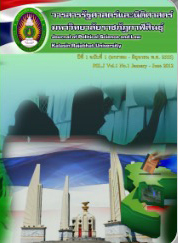“Look” the Principles of the Local Administration under the 2007 Constitution: “Turn Back” the Establishment of the Civil Governance under the Royal Initiative of His Majesty the King Rama VII
DOI:
https://doi.org/10.14456/gjl.2012.2Keywords:
การประชาภิบาล, การปกครองท้องถิ่น, การกระจายอำนาจ, พระปกเกล้าเจ้าอยู่หัว, Civil Governance, Local Administration, Power Distribution, King Rama VIIAbstract
การปกครองส่วนท้องถิ่นถือว่าเป็นรูปแบบการเรียนรู้และการฝึกฝนทางการเมืองของประชาชนเพื่อสร้างความเข้มแข็งและส่งเสริมการมีส่วนร่วมทางการเมือง ในระดับชาติ ก่อนการเปลี่ยนแปลงการปกครองจากระบอบสมบูรณาญาสิทธิราชย์สู่ ระบอบประชาธิปไตยอันมีรัฐธรรมนูญเป็นกฎหมายสูงสุดสยามประเทศได้มีการปกครองในระดับท้องถิ่นมาตั้งแต่สมัยรัชกาลที่ 5 จนกระทั่งถึงสมัยรัชกาลที่ 7 ซึ่งมี แผนการที่จะพระราชทานรัฐธรรมนูญและวางหลักการปกครองของประเทศในระบบรัฐสภาตามอย่างของอารยประเทศส่วนใหญ่และพระองค์มีแนวพระราชดำริที่จะจัดการปกครองท้องถิ่นให้เป็นแหล่งเรียนรู้ทางการเมืองของราษฎรในระดับล่างก่อนโดยมีการตั้งคณะกรรมการศึกษาและเตรียมให้มีการร่างพระราชบัญญัติเทศบาลหรือ ประชาภิบาลขึ้น เพื่อปรับปรุงและพัฒนาระบบการปกครองท้องถิ่นของสยามในขณะนั้นให้มีประสิทธิภาพและสามารถเลี้ยงตนเองได้จากแนวพระราชดำริดังกล่าว ผู้เขียนเห็นว่ามีลักษณะที่สอดคล้องกับแนวความคิดการกระจายอำนาจไปสู่องค์กรปกครองส่วนท้องถิ่นหลังการประกาศใช้รัฐธรรมนูญฉบับ พ.ศ.2540 ซึ่งกล่าวกันว่า เป็นรัฐธรรมนูญฉบับประชาชน หลายประการ เช่น การกำหนดรูปแบบองค์กร การบริหารงาน การกำกับดูแล เป็นต้นบทความชิ้นนี้จึงมุ่งหมายที่จะศึกษาพัฒนาการทาง แนวคิดและเปรียบเทียบลักษณะต่างๆของแนวพระราชดำริในการกระจายอำนาจในยุคของสมบูรณาญาสิทธิราชย์ในช่วง พ.ศ.2469-2474 และหลักการกระจายอำนาจ ตามรัฐธรรมนูญฉบับปัจจุบัน ซึ่งมีฐานคิดในการศึกษาว่า หากไม่มีแนวพระราชดำริใน เรื่อง “การประชาภิบาล” เพื่อพัฒนาการปกครองท้องถิ่นในสมัยนั้น ก็คงไม่มีหลักการ กระจายอำนาจที่เป็นรูปธรรมดังปรากฏในรัฐธรรมนูญฉบับปัจจุบันนี้ ซึ่งจะนำไปสู่การ สร้างฐานคิดในการพัฒนาการปกครองท้องถิ่นไทยให้เป็นฐานการเรียนรู้และการ ฝึกฝนทางการเมืองของประชาชนในท้องถิ่นเพื่อสร้างความเข้มแข็งและส่งเสริมการมี ส่วนร่วมทางการเมืองในระบอบประชาธิปไตยในระดับชาติต่อไป
The local administration is the pattern of political knowledge and training for the citizen to strengthen and support the political participation in the national level. Before changing the form of government from the monarchy to the democracy with the constitution to be a supreme law, Siam had established the local administration since the King Rama V era until the King Rama VII era that had the plan to provide the constitution and laid out the form of government with the parliament system the same as most civilized countries. His majesty the King Rama VII had the royal initiative to establish the civil governance to be the political knowledge source of the grass root citizen by setting the committee and preparing the draft of municipal act to improve and develop the local administration of Siamat that time to be more efficient and self employed. From the royal initiative, the author has the opinion agreeable with the concept of power distribution to the local administration after the 1997 constitution established which is called to be the citizen constitution in several aspects such as the organization pattern setting, administration, regulation, etc. This article aims to study the concept development and compare the characteristics of the royal initiative to distribute the power in the monarchy era during 1926- 1931 and the power distribution principle under the present constitution. The basic idea to study will be on that if there was no royal initiative about “civil governance” to develop the local administration at that time, it will not have the concrete principle of the power distribution occurred in the present constitution that leads to the construction of the basic concept of the local administration development to be the knowledge source and political training of the local citizen to strengthen and support the political participation in the national level later.
Downloads
Downloads
Published
How to Cite
Issue
Section
License
Copyright (c) 2017 วารสารการบริหารปกครอง (Governance Journal) มหาวิทยาลัยกาฬสินธุ์

This work is licensed under a Creative Commons Attribution-NonCommercial-NoDerivatives 4.0 International License.








